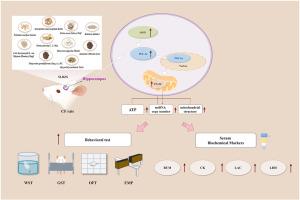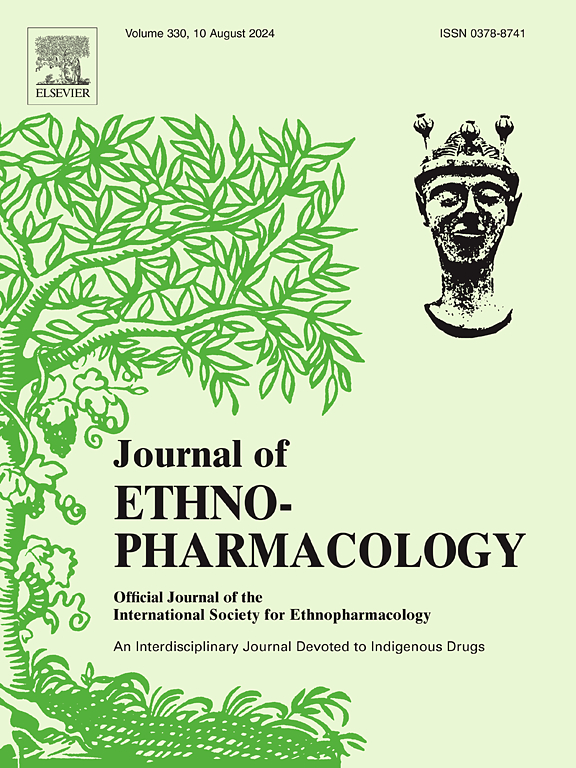神灵白术散通过SIRT1-PGC-1α介导的线粒体生物生成缓解中枢疲劳
IF 4.8
2区 医学
Q1 CHEMISTRY, MEDICINAL
引用次数: 0
摘要
民族药理学相关性:神灵白术散(SLBZS)是一种传统中药配方,由 10 味药材组成,历来用于健脾补气,缓解疲劳相关症状。SLBZS源于宋代的《太平惠民和剂局方》。中枢疲劳(CF)是疲劳的一种亚型,中医认为与脾虚密切相关。然而,目前尚缺乏有关 SLBZS 对中枢疲劳的治疗作用及其潜在益处的药理机制的研究:本研究旨在评估 SLBZS 对改良多平台法(MMPM)诱导的大鼠 CF 的影响,并阐明其潜在机制,重点关注线粒体生物生成和 SIRT1/PGC-1α 通路调控:采用 MMPM 法诱导雄性 Wistar 大鼠产生 CF,包括间歇性剥夺睡眠 21 天。分别给予低剂量(LSLBZS)、中等剂量(MSLBZS)和高剂量(HSLBZS)的 SLBZS。采用液相色谱-串联质谱法(LC-MS/MS)对SLBZS的化学成分进行鉴定和定量。行为测试评估了体能表现、情绪状态和认知功能,同时分析了血清生化指标、线粒体形态以及 SIRT1/PGC-1α 通路的蛋白质和基因表达水平,以探索其潜在机制:结果:SLBZS中共鉴定出141种主要化合物,包括黄酮类、苯丙类、萜类等多种成分。SLBZS能明显改善CF大鼠的体能表现,缓解负面情绪,增强认知功能。在生物化学方面,SLBZS 可提高血清 ATP 水平,降低疲劳相关指标。线粒体分析表明,SLBZS 逆转了线粒体退化,增加了线粒体数量,并增加了海马中的 mtDNA 拷贝数。此外,SLBZS 还在蛋白和基因水平上上调了海马中 SIRT1 /PGC-1α 通路的表达。值得注意的是,HSLBZS 组的效果尤为明显:SLBZS通过上调SIRT1/PGC-1α途径,明显缓解了CF症状,增强了线粒体功能。本文章由计算机程序翻译,如有差异,请以英文原文为准。

Shenling Baizhu San alleviates central fatigue through SIRT1-PGC-1α-Mediated mitochondrial biogenesis
Ethnopharmacological relevance
Shenling Baizhu San (SLBZS) is a Traditional Chinese Medicine (TCM) formula composed of 10 medicinal herbs, historically used to strengthen the spleen, replenish qi, and alleviate fatigue-related symptoms. SLBZS originates from the 'Taiping Huimin Heji Ju Fang' of the Song Dynasty. Central fatigue (CF), a subtype of fatigue, is considered in TCM to be closely associated with spleen deficiency. However, there is currently a lack of research on SLBZS's therapeutic effects on CF and the pharmacological mechanisms underlying its potential benefits.
Aim of the study
This study aims to assess the effects of SLBZS on CF in rats induced by the Modified Multiple Platform Method (MMPM) and to elucidate the underlying mechanisms, focusing on mitochondrial biogenesis and SIRT1/PGC-1α pathway regulation.
Materials and methods
CF was induced in male Wistar rats using MMPM, involving intermittent sleep deprivation over 21 days. SLBZS was administered at low(LSLBZS), medium(MSLBZS), and high doses(HSLBZS). Chemical components of SLBZS were identified and quantified using Liquid Chromatography-Tandem Mass Spectrometry(LC-MS/MS). Behavioral tests evaluated physical performance, emotional state, and cognitive function, while serum biochemical markers, mitochondrial morphology, and the protein and gene expression levels of the SIRT1/PGC-1α pathway were analyzed to explore underlying mechanisms.
Results
A total of 141 main compounds in SLBZS were identified, comprising various components such as flavonoids, phenylpropanoids, terpenoids, among others. SLBZS significantly improved physical performance, alleviated negative emotions, and enhanced cognitive function in CF rats. Biochemically, SLBZS increased serum ATP levels and reduced fatigue-related markers. Mitochondrial analysis demonstrated that SLBZS reversed mitochondrial degeneration, increased mitochondrial number, and increased mtDNA copy number in the hippocampus. Furthermore, SLBZS upregulated SIRT1/PGC-1α pathway expression at both the protein and gene levels in the hippocampus. Notably, the HSLBZS group demonstrated particularly pronounced effects.
Conclusion
SLBZS significantly alleviates CF symptoms enhances mitochondrial function via upregulating the SIRT1/PGC-1α pathway, positioning it as a promising alternative for CF management by addressing both its physiological and symptomatic aspects.
求助全文
通过发布文献求助,成功后即可免费获取论文全文。
去求助
来源期刊

Journal of ethnopharmacology
医学-全科医学与补充医学
CiteScore
10.30
自引率
5.60%
发文量
967
审稿时长
77 days
期刊介绍:
The Journal of Ethnopharmacology is dedicated to the exchange of information and understandings about people''s use of plants, fungi, animals, microorganisms and minerals and their biological and pharmacological effects based on the principles established through international conventions. Early people confronted with illness and disease, discovered a wealth of useful therapeutic agents in the plant and animal kingdoms. The empirical knowledge of these medicinal substances and their toxic potential was passed on by oral tradition and sometimes recorded in herbals and other texts on materia medica. Many valuable drugs of today (e.g., atropine, ephedrine, tubocurarine, digoxin, reserpine) came into use through the study of indigenous remedies. Chemists continue to use plant-derived drugs (e.g., morphine, taxol, physostigmine, quinidine, emetine) as prototypes in their attempts to develop more effective and less toxic medicinals.
 求助内容:
求助内容: 应助结果提醒方式:
应助结果提醒方式:


